.
.
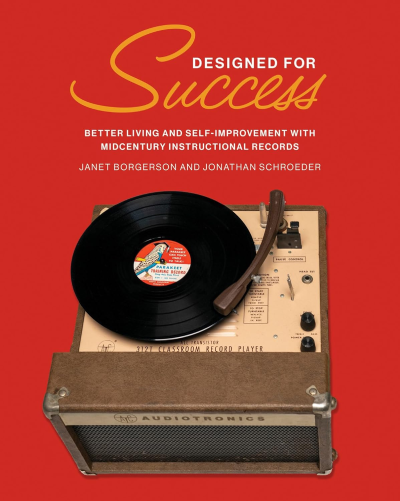
Designed for Success: Better Living and Self-Improvement with Midcentury Instructional Records (MIT Press, 2024), by Janet Borgerson and Jonathan Schroeder
.
.
___
.
.
“A brilliant and delightfully rendered analysis of how midcentury vinyl records and their covers shaped Americans’ aspirations, domestic spaces, social relationships, career training, and education.”
—Penny Marie von Eschen, William R. Kenan, Jr. Professor of American Studies, University of Virginia; author of Paradoxes of Nostalgia
.
…..Ms. von Eschen’s blurb could apply to every book the cultural critics and historians Janet Borgerson and Jonathan Schroeder have written, including Designed for Hi-Fi Living: The Vinyl LP in Midcentury America (MIT Press, 2017), Designed for Dancing: How Midcentury Records Taught America to Dance (MIT Press, 2021), and now Designed for Success: Better Living and Self-Improvement with Midcentury Instructional Records (MIT Press, 2024).
…..Their passion involves collecting unusual vinyl, and providing insight regarding how the recordings and the cover art tell us something about America at mid-20th century. .Who and what we listened to. Where we went. What we danced to, and where. Who our friends were and how music impacted those friendships. What our cultural challenges and opportunities were.
…..Fascinating discoveries emerge from these products, especially with the benefit of seven decades having gone by, and particularly when Ms. Borgerson and Mr. Schroeder provide their ingenious and entertaining analysis.
…..For example…In this excerpt from Designed for Success, the authors write extensively about music instruction and appreciation records dealing with the subject of jazz.
.
.
___
.
.
Excerpted from Designed for Success: Better Living and Self-Improvement with Midcentury Instructional Records [MIT Press], published with the consent of the authors, Janet Borgerson and Jonathan Schroeder
.
.
…..The inner sleeve from a 1960s album proudly proclaimed: “Everything’s on long-playing records these days…your favorite artists, shows, comedy, movie sound tracks, concerts, drama, documented history, educational material, you name it.” As Conversa-phone’s Children’s Spanish Language Course promised, instructional records are “Simple! Fast! Modern! Fun!” Music instruction and jazz appreciation records make a strong showing.
…..But instructional and self-improvement records have been largely overlooked. We’re not surprised. The cultural significance of entire categories of midcentury vinyl has been underestimated when compared to considerations of film, television, and magazines.
…..The instructional genre included sales training, family life and sex education, beauty, fitness, and music lessons – anything that could be taught might wind up on an instructional record. For example, records offered a convenient way to learn to play musical instruments. A typical “learn to play” album included musical tracks that left one instrument out – so the listener could “fill in” by playing guitar or saxophone along with a band.
…..In our new book, Designed for Success: Better Living and Self-improvement with Midcentury Instructional Records, we celebrate a genre of albums often deemed puzzling, quirky, or outright strange. Each chapter focuses on a designed for success theme that emerged from reflecting on the albums – their cover art, content, and the contexts in which they were released. We discuss instructional album categories such as “Paths to Persuasion: Selling and Salesmanship,” “Family Fidelity: The Harmonious Marriage and Well-adjusted Children,” and “Learning to Listen: Music Appreciation.” Instructional records helped advance the self-improvement project and provide rich material for insight, and hopefully, some entertaining humor. Detailed liner notes, illustrated booklets, pedagogical design, and album cover art offer intriguing treasures and sample surprisingly sage advice.
…..Here, we present a few of the jazz-related titles featured in the book.
.
…
.
…..The Music Minus One label emerged as a leader for such “play-along” albums and released hundreds of titles that provide “a unique way to study, rehearse and perform with professional ensembles in the comfort of your own home.” Music Minus One had a few competitors during its early days, including Young Violinists’ Editions from Remington Records, a short-lived label that nonetheless benefitted from covers designed by Alex Steinweiss. Columbia Records introduced “Add-A-Part” records in the 1940s, but didn’t continue the line after the LP was introduced. Savoy Records released a “Jazz Laboratory” series of Do-It-Yourself Jazz records featuring pianist Duke Jordan, with a quartet playing on side one, and the same songs, but without the saxophone, on side two. Jamey Aebersold ‘s Play-A-Long albums are still available.
…..Music Minus One’s founder Irv Kratka, a jazz enthusiast who produced his first record as a teenager, also ran Inner City, Classic Jazz, and Proscenium Records. Dubbed “the godfather of karaoke,” Kratka released over 1000 Music Minus One discs. Music Minus One recruited top names to play on their records, including first chairs at leading American orchestras and top names in jazz, including Max Roach, Stan Getz, and Hank Jones. Their motto: “For the first time, even hobbyist players could solo with a professional orchestra.”
…..Music Minus One’s albums included a catalogue insert that listed categories such as “The Wonderful World of Guitar,” “Concert Band,” and “Self-Instruction Kits.” Each Music Minus One volume “contains a 12” long play record of background accompaniment to each selection played by an All-Star rhythm section. The music ranges from easy through medium to difficult.” As Harold Schonberg, the venerable New York Times classical music critic noted: “there’s a certain psychological benefit in MMO. You put the record on, alone in your own house. Nobody is going to raise depreciating eyebrows when you fluff a passage or come in on the wrong half of the measure. You can bluff to your heart’s content.”
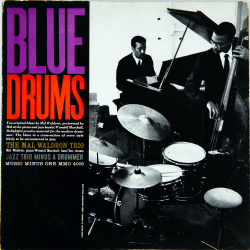
Blue Drums
The Mal Waldron Trio
Music Minus One MMO 4005;
design by Sy Rudman
photo by David Gahr, 1961.
…..On Music Minus One’s Blue Drums, The Mal Waldron Trio includes brief biographies of the featured musicians, pianist Mal Waldron and bassist Wendell Marshall, leaving space for “you” on drums. Waldron appears on a couple of other Music Minus One discs, including The Blues Minus You – Ten Shades Of Blue and For Singers ‘N Swingers – Sing Or Play With The Mal Waldron Trio.
…..Waldron was a successful jazz musician and composer, playing with legends like John Coltrane, Eric Dolphy, and Charles Mingus, and as a regular accompanist for Billie Holiday. He can be heard on many classic Prestige Records recordings. After a heroin overdose, he struggled to remember how to play the piano and “had to teach himself how to play again, partly by listening to his own records,” as a 2002 obituary reported. So, perhaps the Music Minus One titles he contributed to reflect Waldron’s own experience of learning by listening.
…..The album includes notes on the “chorus form” and “song form,” along with sheet music for the ten original blues songs by Waldron. He provides a rationale for the LP: “Most jazz albums contain one or two blues and unless you can play them you never really make it with the cats.” It’s obvious that Waldron was a talented and inspired piano player, and one hardly misses the drums on the recording.
…..The cover photograph for Blue Drums is by David Gahr, whose photographs grace hundreds of album covers. His classic images of jazz and rock musicians include shots of Miles Davis and Janis Joplin that appeared on US Post Office stamps. He started at Folkways Records, where he shot the covers Brownie McGhee and Sonny Terry Sing (1958) and It’s My Way by Buffy Sainte-Marie (1964). Cover typography is by Sy Rudman, an artist and art director for Argosy magazine who designed many jazz album covers.
.
…
.
…..The Art of Mixing Drinks and Music provides an LP of “musical backgrounds by The Rhythm Makers.” It’s up to the listener to furnish what is missing from this Music Minus One package: Not the piano line, sax solo, or drumbeat, but “The Drink.” Decoratively housed in a special cutaway cover frame, The Art of Mixing Drinks – a small paperback based on “the famous Esquire Drink Book” – features inspiring glassware for your daquiri, Irish coffee, and crème de menthe and contains 1001 cocktail recipes, including a chapter on favorite drinks of famous people, and “365 excuses for a party.”
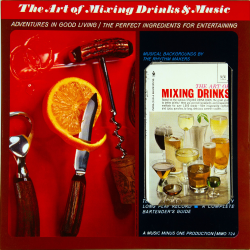
The Art of Mixing Drinks & Music
The Rhythm Makers
Music Minus One MMO 124, c. 1969.
…..Striking scarlet and a selection of bar tools lure the listener to “adventures in good living.” The music is “soft” – allowing conversation – “yet rhythmic, for those who want to dance.” Coming from the MMO team, this fine LP outclasses many “music for” easy listening records and finds its way onto our turntable often. Musicians include esteemed pianist Don Abney, legendary bassist and photographer Milt Hinton, bassist Wilbur Ware, guitarist Barry Galbraith, and drummers Osie Johnson and Bobby Donaldson. There’s a definite bebop influence on “Poor Butterfly” with cellist and bassist Oscar Pettiford and Kenny Clarke’s ride cymbal time keeping. Perfect for drinking, dancing, and discussion.
.
…
.
…..You Can Play …Sonny Rollins featured a black and white photograph of the legendary jazz saxophonist superimposed over a spare graphic brick wall. Rollins, who continues to release records in his 90’s, famously played with Charlie Parker, Thelonious Monk, Miles Davis and John Coltrane. The cover’s homespun appearance belies this jazz instruction record’s extraordinary execution. An “Aebersold Play-A-Long,” the disc is volume 8 of “A New Approach to Jazz Improvisation.”
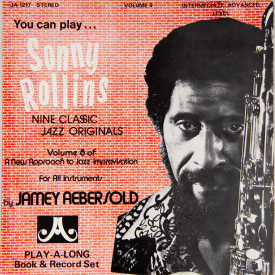
You Can Play …Sonny Rollins
Jamey Aebersold, JA 1217;
cover by Pete Gearhart
cover photo courtesy of Milestone Records, 1976.
…..Released at $8.95 for both the book and the record, the album was aimed at “intermediate/advanced” players. The vinyl record is still available on the Aebersold website: “Even if you don’t own a turntable, they make attractive musical tributes to another era and they are a great way to decorate your studio/practice room.” Side one begins with a B flat tuning note played on piano, followed by a voice (Jamey Aebersold’s presumably) counting out 1,2,1,2,3,4.
…..Aebersold, a talented musician, produced over a hundred Play-A-Long albums. He also presides over Jazzbooks, which continues to distribute the records, as well as other offerings like the Music Minus One series of music instruction records. As recounted in an informative music website Plays Well With Others: “Based on his belief that “anyone can improvise,” Aebersold launched the business with a $500 loan from his parents, and a tiny classified ad in DownBeat.
…..A half-century later, Aebersold Play-A-Long titles (now available as CDs and streaming online) have sold over five million copies worldwide. Aebersold’s records were instrumental for musicians and offered a way to learn jazz away from metropolitan centers, nightclubs, and music schools. The records have aged well.
…..A host of records offer instructions for appreciating and understanding music – especially classical and jazz. During the early 20th century, the popularity of jazz, “race” records, and other, less “cultured” genres had prompted widespread, and often racist, criticism of the recording industry’s cultural influence. Under attack for promoting popular music for the masses, recording companies and gramophone manufacturers emphasize the educational and uplifting potential of listening to and learning about classical music in the comfort of home. As jazz gained respect, record companies began to release “jazz appreciation” albums as well.
.
…
.
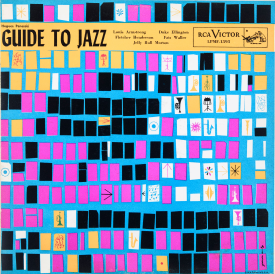
Guide to Jazz
Hugues Panassié
RCA Victor LPMF 1393;
Cover design: Jason Kirby, 1956.
…..Jazz appreciation examples in Designed for Success include the classic Guide to Jazz from Hugues Panassié. Tiny trumpets, drums, directional arrows and other symbols create a computer punch card-like code for musical inputs and outputs that adorn the cover. Artist Jason Kirby’s striking irregular black, white, orange, and fuchsia rectangles against a turquoise background found a home on many LPs: the same modernist grid graphics appear on releases such as Duke Ellington and His Orchestra’s In a Mellowtone (1956) and Tito Puente’s Top Percussion (1958).
…..Guide to Jazz was “issued simultaneously with the publication of Hugues Panassié’s book of the same title.” Reading and listening together recommended. Panassié, an eminent French jazz impresario and critic, authored annotated liner notes for the sixteen musical selections. He provides interesting details about musicians and studio practices, creating a compelling tour through key moments in recorded jazz. “Some Sweet Day” with Louis Armstrong vocal starts off side one. Count Basie’s “One O’clock Boogie,” recorded in 1947, and John Estes’ “Working Man Blues” from 1941, highlight connections to the genre’s deep past, and emphasize the blues’ influence on jazz. “My Blue Heaven” from Coleman Hawkins, “Swingin’ Uptown” with Jimmy Lunceford, and Jimmy Yancy’s 1939 recording of “The Mellow Blues,” among others, present appealing and memorable listening that admirably serve to introduce jazz to the uninitiated. Significant here is the all Black roster of musicians – no Original Dixieland Jazz Band, no Benny Goodman, no Dave Brubeck – a noteworthy departure from most jazz history records of the era.
.
…
.
…..A Child’s Introduction to Jazz, narrated by Julian “Cannonball” Adderley, is part of the Wonderland series from Riverside Records. This wide-ranging set, produced by Riverside’s co-founder Bill Grauer, included A Child’s Introduction to Gilbert and Sullivan (1959) and A Child’s Introduction to Outer Space (1959). Adderley, who played saxophone on Miles Davis’s Kind of Blue, provides a “comprehensive and authoritative introduction to this important American music.” His “highly articulate and well-informed” narration is useful for adults as well as children. As his 1975 obituary mentioned, Adderley “believed in letting his audiences know, in an urbane and witty manner, what his music was about.” The album offers a fascinating contrast to Leonard Bernstein’s celebrated and cerebral What is Jazz from 1956, which seems serious and studious, if typically exuberant, in comparison to Adderley’s warm and personal approach.

A Child’s Introduction to Jazz
narrated by Julian “Cannonball” Adderley
Wonderland Records RLP 1435, 1961.
…..As the liner notes point out, Adderley’s commentary offers “an easy-going, conversational discussion of the highlights of the jazz story.” The record features excerpts from early jazz legends Louis Armstrong, Duke Ellington, Scott Joplin, Jelly Roll Morton, and Ma Rainey, as well as Adderley’s contemporaries John Coltrane, Thelonious Monk, and Wes Montgomery. The sound quality is excellent, as promised on the cover: “These records are conceived, planned and produced by an experienced, expert staff, and are recorded and processed at the finest modern high-fidelity sound studios.”
…..The notes rave: “The story of jazz is the story of an exciting and truly American art form – a music bursting with the vitality of American life.” To learn about jazz, Adderley states “I can only recommend that you listen to records wherever you can and as much as you can.” The fanciful cover art highlights a bowler hatted man with a golden sax emitting colorful representations of unpredictable, even improvisational, sound. A young boy dressed in boater and summer attire shows beginning efforts to play the drum. Given that the liner notes call no specific attention to the contribution of African American people to jazz, nor to the blues and spirituals that preceded jazz, it’s not surprising that Riverside failed to represent a Black musician on the album cover. But sonically, A Child’s Introduction to Jazz is a marvelous record.
.
…
.
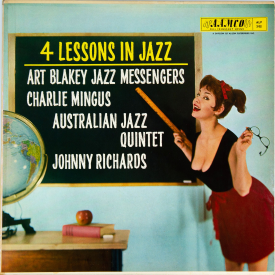
4 Lessons in Jazz
AAMCO ALP 302, 1958.
…..A book and a slightly bruised apple pale in comparison with teacher’s crimson hair ribbon, short skirt, and lipstick. No boring homework here. Whoever left the iconic gift on her desk may be hoping to learn something more than 4 Lessons in Jazz. A piece of white chalk and a globe of Earth complete the midcentury educational setting. The buxom expert, eyeglasses off and ruler in hand, points to the chalkboard highlighting the album’s musicians. Art Blakey Jazz Messengers, Charlie Mingus, Australian Jazz Quintet, and Johnny Richards each provide a lesson: Mingus as “a bold experimentalist” and “a searcher,” Richards as an arranger, the Detroit-based Quintet for “thought-out jazz interpretations,” and the Jazz Messengers, the prolific and long-running group that featured many legendary players, expound on the school of hard bop.
.
…
.
…..Jazz Goes to Junior College documents the Dave Brubeck Quartet’s campus tour that garnered national attention and landed Brubeck on the cover of Time magazine in 1954, with the headline “The joints are really flipping.” Not quite as celebrated as the Quartet’s first collegiate release, the best-selling Jazz Goes to College, the junior version featured Paul Desmond on alto sax, Norman Bates on bass, and Joe Morello on drums. As the liner notes explain: “the five outstanding Brubeck Quartet interpretations in this set came from two concerts at junior colleges – Fullerton and Long Beach.” Brubeck’s emphasis on seeking out audiences beyond night clubs required helping people “get acquainted with jazz.” His mission included helping “the students learn about the jazz heritage which is theirs to enjoy” and defy the “past generations of educators” who had the sense that jazz was “something to be ignored or considered undignified or downright bad.”
…..The album includes a fantastic version of “One Moment Worth Years,” along with “Bru’s Blues,” as well as extended interpretation of standards “These Foolish Things,” “The Masquerade Is Over,” and “St. Louis Blues,” all enthusiastically received by the collegiate audiences, as evidenced by the approving applause on the record. The erudite and enlightening liner notes were penned by legendary producer George Avakian. His notes provide context for Brubeck’s college tours: “Campus concerts prior to the early fifties consisted of classical music series sponsored by the schools; beginning in 1952, student organizations, or small groups of students acting with the faculty permission but independently of an official university group, began to engage jazz artists to appear on individual concerts.”
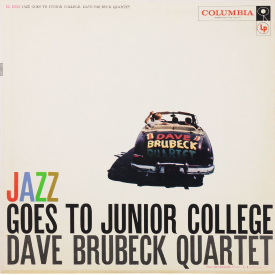
Jazz Goes to Junior College
Dave Brubeck Quartet
Columbia CL 1034;
photo by Garry Winogrand, 1957.
…..Janet’s 93-year-old dad fondly remembers helping bring the Dave Brubeck Quartet to Ann Arbor in 1954 when he was a student at the University of Michigan. (He also recalls his friend’s girlfriend running off with Paul Desmond after the concert at the Masonic Temple, which provided five tracks for Jazz Goes to College.)
…..The back cover of Jazz Goes to Junior College includes a promotion for Columbia’s line of record players and hi-fi consoles, with a photo of model 530. They promise “guaranteed high fidelity and hemispheric sound.”
.
…
.
…..By midcentury, record players were an essential tool for most US schools. Although classroom use of phonographs waned by the 1980s, up until then, records players, used for solo listening through headphones and for group instruction, formed a significant component of educational technology. Today, of course, podcasts, YouTube videos, educational subscriptions like Masterclass, with their slogan “gain new skills in 10 minutes,” and television shows have taken over the instructional realm, as virtual reality and artificial intelligence loom as the next paradigm shift for learning to play and appreciate music.
…..The history of the recording industry often focuses on greatness – great inventors, great innovators, greatest hits. Another facet of the story concerns the original promise of records as instructional tools, and the ways such records tapped into America’s deepest longings. From the earliest days of the phonograph, customers were encouraged to think of their purchases as acts of discernment, aimed at “improving” their musicality, showing off their taste, and signaling their modernity and sophistication. Instructional records provide a unique window into how midcentury Americans were encouraged to imagine themselves and contribute to the postwar boom in productivity.
…..We’d love to hear if anyone has experience with music instruction records! Did you learn to play sax with a Music Minus One LP? Please comment or add your memories.
.
.
___
.
.
photo by Ria Tafani
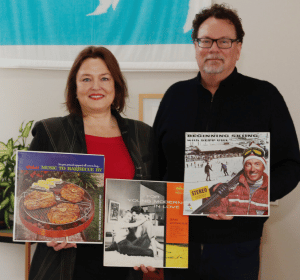
Janet Borgerson and Jonathan Schroeder are co-authors of Designed for Hi-Fi Living: The Vinyl LP in Midcentury America (MIT Press, 2017), Designed for Dancing: How Midcentury Records Taught America to Dance (MIT Press, 2021), and Designed for Success: Better Living and Self-Improvement with Midcentury Instructional Records (MIT Press, 2024).
.
.
Excerpted from Designed for Success: Better Living and Self-Improvement with Midcentury Instructional Records [MIT Press], published with the consent of the authors
.
.
Click here to read our interview with Janet and Jonathan about their book, Designed For Dancing: How Midcentury Records Taught America to Dance
Click here to read an excerpt from that book
Click here to read outtakes from that book
Click here to read more outtakes from that book
.
.
___
.
.
Click here to help support the ongoing publication of Jerry Jazz Musician, and to keep it commercial-free (thank you!)
.
Click here for information about how to submit your poetry or short fiction
Click here to subscribe to the (free) Jerry Jazz Musician quarterly newsletter
.
___
.
.
Jerry Jazz Musician…human produced (and AI-free) since 1999
.
.
.


































